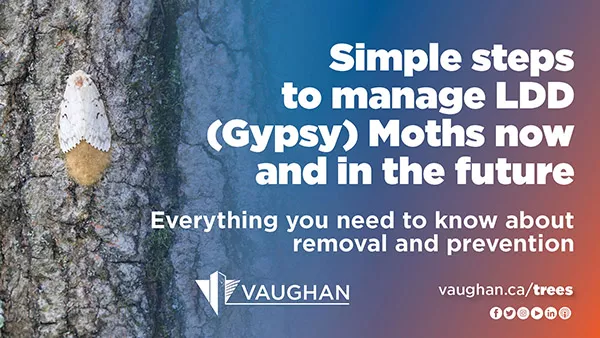Simple steps to manage LDD (Gypsy) Moths now and in the future
Everything you need to know about removal and prevention
You have likely seen LDD Moths (Gypsy Moths) on trees and bushes throughout Vaughan this spring and summer. Around this time of year, the adult moths mate and leave spongy egg masses on tree trunks and branches – there will be no further damage to trees in 2021. To keep these pests from making a home on your property, the City of Vaughan offers simple steps for removal and future prevention.
You have likely seen LDD Moths (Gypsy Moths) on trees and bushes throughout Vaughan this spring and summer. Around this time of year, the adult moths mate and leave spongy egg masses on tree trunks and branches – there will be no further damage to trees in 2021. To keep these pests from making a home on your property, the City of Vaughan offers simple steps for removal and future prevention.
What homeowners can do
Use the following step to help protect your trees from these invasive insects:
- Scrape off and destroy egg masses by submerging them in a bucket of water and soap for at least two days. After that time, discard of the solution and egg mixture. Doing this will help prevent more caterpillars from hatching in the future.
- It is important to look thoroughly on your property for egg masses as they can also be found on benches, firewood, outdoor furniture, swing sets and under the eaves of buildings.
To help promote new leaf growth, water the trees that have been affected by LDD Moths. Visit vaughan.ca/water to view water use information. If you have concerns about affected trees on your property, contact an arborist or a licensed tree care company.
What the City does to control LDD Moths on public property
To help control the LDD Moth population this year, the City began city-wide treatment in May in heavily infested areas. Currently, the City has placed barrier bands on over 1,200 trees, and approximately 6,600 egg masses from nearly 1,000 public trees have been removed. To receive up-to-date information on the City’s continued efforts to control these insects, visit vaughan.ca/trees.
From early May to mid-July, LDD Moth caterpillars eat leaves from hardwood trees such as oak, maple, birch and aspen, and select shrubs. While forested areas in York Region may be affected, trees in urban areas – including on local and regional roads and on private property – are most at risk. Soil compaction, air pollution and other pests and diseases make trees in urban areas more susceptible to infestation. However, affected trees that are healthy will usually grow a second crop of leaves in the same season.
LDD Moths also have natural enemies that aid in reducing the population in highly infested areas. These include soil borne bacteria, squirrels, chipmunks, raccoons, skunks, more than 15 species of birds and several native insects. City staff have noted outbreak levels of NPV virus, a natural and detrimental pathogen to LDD caterpillars – harmless to humans and animals – throughout City-wide “hot spot” locations.
In an ongoing effort to lead inclusive organizations, Toronto and Region Conservation Authority (TRCA) and the City of Vaughan are transitioning away from the use of “Gypsy Moth” and will be using the term “LDD Moth” moving forward.
For more information and links to resources, visit the City’s LDD Moth webpage, the Ministry of Agriculture, Food and Rural Affair’s webpage or york.ca/LDDMoth.
To receive the City’s latest updates as they happen, sign up for the City Update eNewsletter at vaughan.ca/CityUpdate and follow the City’s Twitter, Facebook, Instagram and LinkedIn channels.
-30-

